This pub is closed permanently. Your nearest Wetherspoon pub: The Amber Rooms, Loughborough
The word ‘moon’ appears in the name
of several Wetherspoon pubs, linking them with the ideal pub envisaged by George
Orwell. The author called his fictional pub
‘Moon Under Water’. The ‘bell’ refers to
bell-making which has made Loughborough famous worldwide. The building stands on
the site of Atherstone House. Built in 1790, the house later became a boarding
school and was demolished in 1938 and replaced by Income Tax offices which are
now this pub.
Prints and text about Thomas Cook.
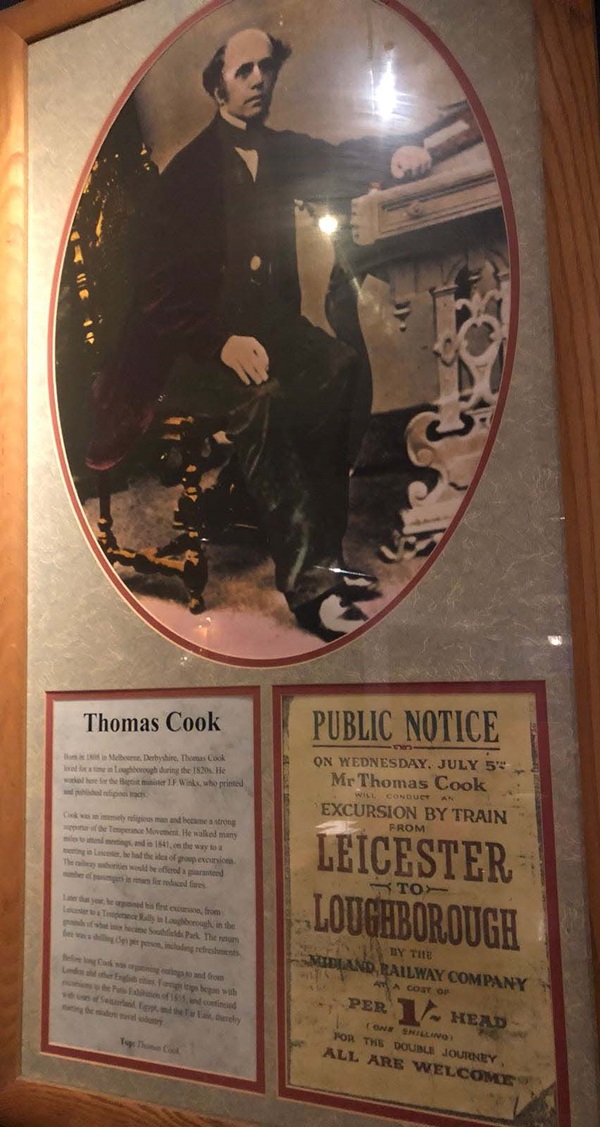
The text reads: Born in 1808 in Melbourne, Derbyshire, Thomas Cook lived for a time in Loughborough during the 1820s. He worked here for the Baptist minister JF Winks, who printed and published religious tracts.
Cook was an intensely religious man and became a strong supporter of the Temperance Movement. He walked many miles to attend meetings, and in 1841, on the way to a meeting in Leicester, he had the idea of group excursions. The railway authorities would be offered a guaranteed number of passengers in return for reduced fares.
Later that year, he organised his first excursion, from Leicester to a Temperance Rally in Loughborough, in the ground of what later became Southfields Park. The return fare was a shilling (5p) per person, including refreshments.
Before long Cook was organising outings to and from London and other English cities. Foreign trips began with excursions to the Paris Exhibition of 1855, and continued with tours of Switzerland, Egypt, and Far East thereby starting the modern travel industry.
Top: Thomas Cook.
Prints, illustrations and text about Lords of the Manor.
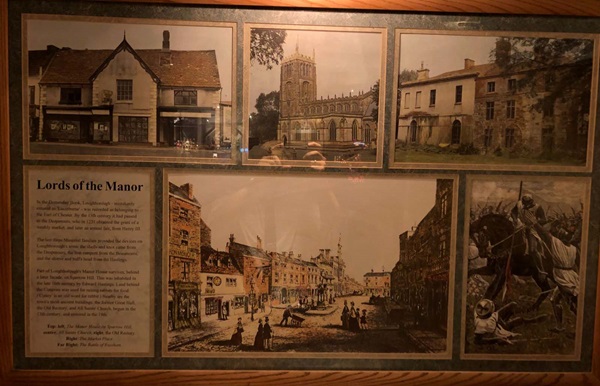
The text reads: In the Domesday Book, Loughborough – mistakenly entered as ’Lucteburne’ – was recorded as belonging to the Earl of Chester. By the 13th century it had passed to the Despensers, who in 1221 obtained the grant of a weekly market, and later an annual fair, from Henry III.
The last three Manorial families provided the devices on Loughborough’s arms: the shells and knot came from the Despensers, the lion rampant from the Beaumonts, and the sleeve and bull’s head from Hastings.
Part of Loughborough’s Manor House survives, behind a later façade, on Sparrow Hill. This was inhabited in the late 16th century by Edward Hastings. Land behind the Coneries was used for raising rabbits for food. (‘Coney’ is an old word for rabbit.) Nearby are the town’s most ancient buildings: the former Great Hall, the Old Rectory, and All Saints’ Church, begun in the 13th century, and restored in the 19th.
Top: left, the manor on sparrow hill, centre, All Saints Church, right, the old rectory.
Right: The market place
Far right: The battle of Evesham.
Prints and text about Ladybird Books.
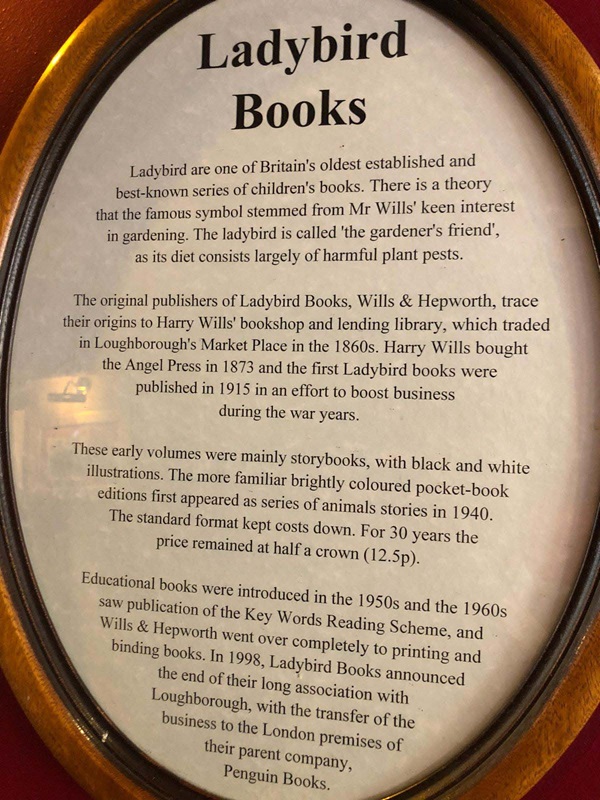
The text reads: Ladybird are one of Britain’s oldest established and best-known series of children’s books. There is a theory that the famous symbol stemmed from Mr Wills’ keen interest in gardening. The ladybird is called ‘the gardener’s friend’, as its diet consists largely of harmful plant pests.
The original publisher of Ladybird Books, Wills & Hepworth, trace their origins to Harry Wills’ bookshop and lending library, which traded in Loughborough’s Market Place in the 1860s. Harry Wills bought the Angel Press in 1873 and the first Ladybird books were published in 1915 in an effort to boost business during the war years.
These early volumes were mainly storybooks, with black and white illustrations. The more familiar brightly coloured pocket-book editions first appeared as series of animal stories in 1940. The standard format kept costs down. For 30 years the price remained at half a crown (12.5p).
Educational books were introduced in the 1950s and the 196’s saw publication of the Key Words Reading Scheme, and Willis & Hepworth went over completely to printing and binding books. In 1998, Ladybird Books announced the end of their long association with Loughborough, with the transfer of the business to the London premises of their parent company, Penguin Books.
Prints and text about Atherstone House.
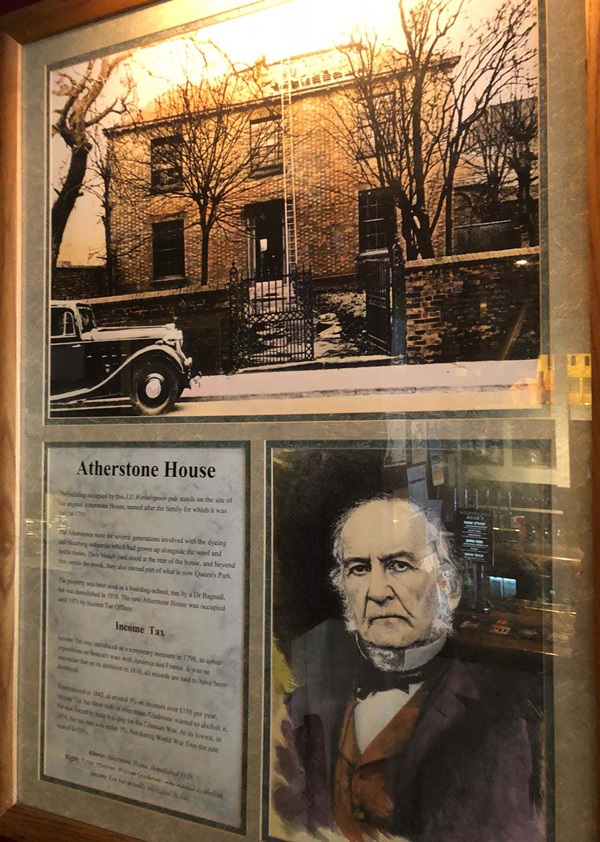
The text reads: The building occupied by this J D Wetherspoon pub stands on the site of the original Atherstone House, named after the family for which it was built in 1790.
The Atherstones were for several generations involved with the dyeing and bleaching industries which had grown up alongside the wool and textiles trades. Their bleach yard stood at the rear of the house, and beyond that, across the brook, they also owned part of what is now Queen’s Park.
The property was later used as a boarding school, run by a Dr Bagnall, but was demolished in 1938. The new Atherstone House was occupied until 1971 by Income Tax Offices.
Income tax was introduced as a temporary measure in 1797 to cover expenditure in Britain’s wars with American and France. It was so unpopular that on it abolition in 1816, all records are said to have been destroyed.
Reintroduced in 1842, at around 3% on incomes over £150 per year, income tax has now been with us ever since. Gladstone wanted to abolish it, but was forced to raise it to pay for the Crimean War. At its lowest, in 1874, the tax rate was under 1%, but during World War Two the rate soared to 50%.
Above: Atherstone House, demolished 1938
Right: Prime minister, William Gladstone, who wanted to abolish income tax but actually increases its rate.
Photographs of the Odeon, Loughborough, c1936.
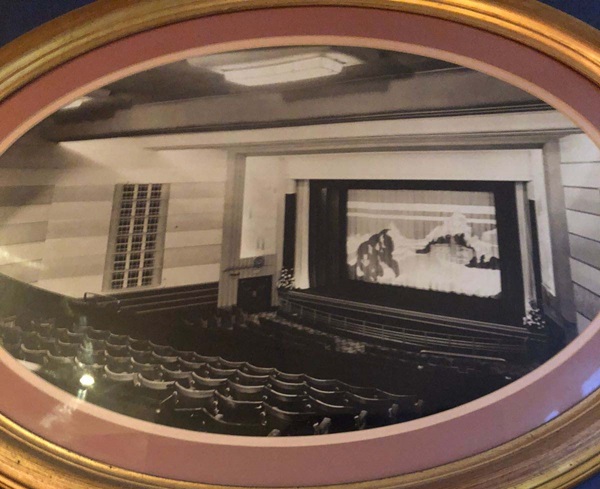
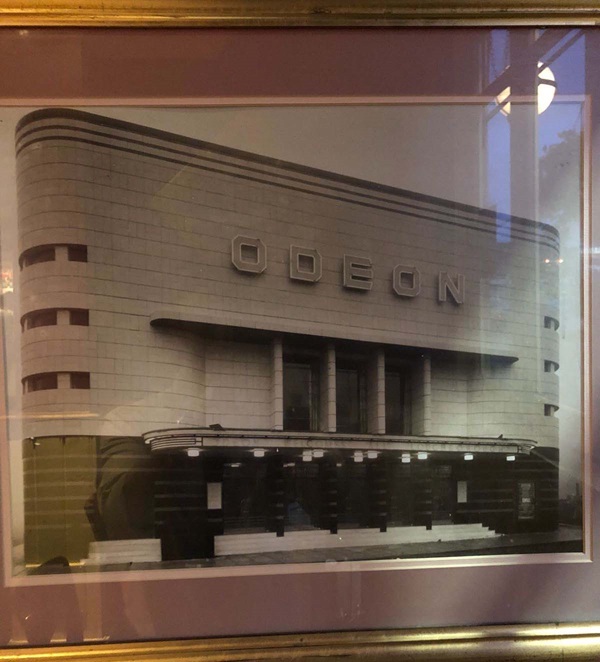
External photograph of the building – main entrance.
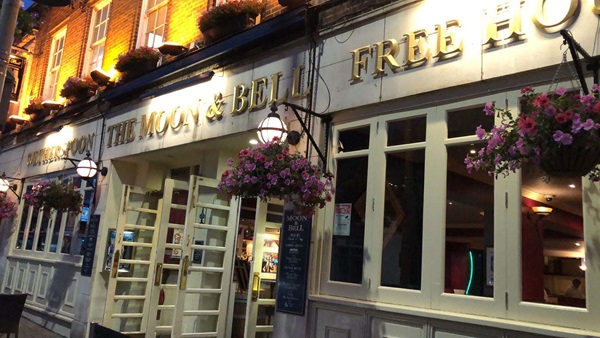
If you have information on the history of this pub, then we’d like you to share it with us. Please e-mail all information to: pubhistories@jdwetherspoon.co.uk